

Vol. 41 (Issue 12) Year 2020. Page 17
VOYNARENKO, Mykhaylo 1; DYKHA, Mariia V. 2; НUROCHKINA, Viktoriya V. 3; MENCHYNSKA, Olena M. 4
Received: 22/12/2019 • Approved: 14/03/2020 • Published 09/04/2020
ABSTRACT: The proposed approach can be used to determine the impact of factors on the performance of enterprises when creating cluster associations in different industries; enables forecasting of the results of activity of enterprises with optimal values of resource supply of production and supply chains of value added; creates an opportunity to optimize business processes for the development and adoption of sound management decisions; solves the problem of comparative analysis; can serve as a basis for solving underused formal problems. |
RESUMEN: El enfoque propuesto se puede utilizar para determinar el impacto de los factores en el desempeño de las empresas al crear asociaciones de clúster en diferentes industrias; permite pronosticar los resultados de la actividad de las empresas con valores óptimos de suministro de recursos de producción y cadenas de valor agregado; crea una oportunidad para optimizar los procesos comerciales para el desarrollo y la adopción de decisiones de gestión sólidas; resuelve el problema del análisis comparativo; puede servir como base para resolver problemas formales infrautilizados. |
The current state of the dynamic business environment is characterized by rigid requirements to the process of management of enterprises, due to the orientation forwards achieving the possible maximum end results in terms of using the minimum possible cost of resources.
A positive step in solving many problems is the separation of functioning business entities by establishing connections within the cluster associations, which is logically justified by their activity and the directions of the results of the activity of each of the members of the association (these are enterprises that carry out: analysis of the needs of car market consumers, car production or participation in such production, auto sales, after sales and services).
Integrated communications are characterized by vertical sequential actions in the process of supplying resources, production, sales, after-sales and services. The integrated production and distribution chain of the cluster association covers the processes from the very beginning (input conditions for the implementation of business processes) up to the product market and appropriate service. The result of the effective integration of the production and sales business processes of the cluster association at the outlet is the economically advantageous conditions for the production, sale, service of products, effective process management, and implementation of opportunities for efficient use of capacities, optimization of business processes at each stage of the production and distribution chain added value. It updates the clarity of presentation and uses in the process of enterprise management of objective dependencies existing between the inputs of business processes (input conditions, cost of resources), on the one hand, and outcomes of business processes (activities) of enterprises, on the other hand. Therefore, it is relevant to determine the influence of factors on the activities of enterprises in the system of integration association with the help of tools of economic and mathematical modeling in order to analyze and take into account their significance and conduct a forecast of the performance of enterprises in the value chain.
Problems of the analysis of the efficiency of the operation of production systems, the formation of production and technological Infrastructure, sales chains within the cluster association, are given attention in the works of leading foreign and domestic scientists.
For the first time, the concept of the chain value was identified by Porter (1985) as the value for which the consumer is willing to pay the asking price. In addition, he noted that the basis of competitive advantages is formed by organizing various activities with different efficiency.
Hudson (2004), a representative of the modern science of integrated networking (network), identified axioms that occupy a central place in the conceptualization of economic geography and noted that economic processes should be conceptual in terms of constructing a complex scheme with a multitude of links and loopback loops rather than simply "simple" schemes or, even worse, linear flows.
In the field of business process management methodology at industrial enterprises, the method of operational management of production is effectively applied, which is based on the task of minimizing waste and stocks, intensifying and optimizing business processes and accelerating the introduction of new products into the market. Mansson (2003) notes, that the combination of methods for analyzing the efficiency of the economic systems functioning in the economic literature is divided into two groups. The first group includes methods for calculating coefficients (discounted cash flow method, income capitalization method, payback method, calculation of the break-even point of the project), methods of the second group based on the application of the econometric approach which, according to Blagoudir (2016), is based on the notion of marginal efficiency that is determined taking into consideration the approximation of the values of the indicators of a separate enterprise to the potential or actual efficiency boundary, which is calculated on the basis of the production function.
In modern conditions, the significance of innovation activity has increased for ensuring / achieving enterprise development. In this context, the research (Dykha et.al., 2017), in which the authors developed a model of activation of investment and innovation activity, substantiated the priorities of structural and innovation restructuring of the economy, as well as the directions of development of venture business and stimulation of production of high-tech, competitive products, is relevant.
The theoretical basis for the evaluation and implementation of the economic-mathematical modeling of the innovation component of business processes is the work of Fasse et.al. (2011), the authors of "Recent developments in applying environmental value chain analysis" highlight an innovative component in the functioning of the value chain. They analyzed the relationships between the innovation strategy and the effectiveness of the introduction of innovations (in the production and supply chain of service provision), carried out on the example of the Malaysian telecommunications industry. According to the results of the study, it was revealed that the generation of ideas and their dissemination / introduction significantly affects the innovation strategy of the company, while the innovative strategy has a positive impact on the development of services and their promotion.
The application of the tools of economic and mathematical modeling in the study "Assessment of an enterprise's energy security based on multi-criteria tasks modeling" gave the opportunity to authors Voynarenko, Dykha et.al. (2018) to determine the significance of the influence of the set of factors on the energy security of the enterprise, forming a model of the hierarchy of factors, and founding the relationship of factors and their impact on the energy security of the enterprise. The application of the developed scientific-methodical approach makes it possible to develop optimal / coordinated management decisions in the context of the formation and provision of energy security. Considerable attention in studying the problems of reforming the economy of Ukraine and its regions on the basis of cluster technologies is given in the work of Voynarenko (2000), in which for the first time in the Ukrainian economy the definition of clusters as territorial-sectoral voluntary associations of enterprises was given, which closely cooperate with scientific institutions and local authorities, in order to increase the competitiveness of their own products and economic growth of the region. Research on clusterization, the formation of an innovative model of cooperation and the use of cluster tools in the development of subregional strategies for improving the competitiveness of the region's economy were further developed in the articles by the authors of Voynarenko & Bohatchyk (2014) and Voynarenko & Menchynska (2018).
Also, the study of clusterization as a form of internal integration and a new model of economic growth, based on the use of competitive advantages of regions and a combination of industrial, scientific and managerial potential of the domestic economy, devoted their work to Kozhukhivska et.al. (2017).
Hurochkina (2015) noted that the innovation potential organically integrates the main potential opportunities of the enterprise for realization of innovative development. Hurochkina & Menchinska (2018) investigated the integration chains and the place of Ukrainian engineering in international rankings. Zakharkin et.al. (2019) analyzed the directions of innovative development of industrial enterprises.
Melikhov (2014) worked out the process of modeling the production capacities of the enterprises of machine building of Ukraine within the framework of already formed clusters. Investigating the connection between the integral coefficient of innovation activity and gross revenues, the value of assets and the cost of the wage fund, the author notes that due to improvement of production factors and increase of innovation activity of the enterprises of machine building industry of Ukraine, it is possible to increase the gross income of the investigated fields of the industry. However, it is worth noting that Melikhov has been somewhat incomplete in research on the application of the results of modeling of production processes in optimizing the processes of consumption of industrial resources and the formation of cluster associations and the use of practical mechanisms for the introduction of innovations in the activity of enterprises of automobile industry.
Despite a large number of scientific works devoted to the functioning of the value chains in production networks, clusters, associations and the construction of economic and mathematical modeling of business processes, the construction of business models of enterprise development in the structure of national economies, requires further study of the question of determining the impact of factors on business -processes by simulation.
Therefore, the purpose of the study is to determine the influence of factors (including innovation) on the efficiency of the enterprises of mechanical engineering in the production and distribution chains of added value by modeling, as well as forecasting the results of enterprises in the conditions of a cluster association, based on the consideration of the significance of the influence of various factors.
The theoretical and methodological basis of the research is the scientific works of domestic and foreign authors on the problems of managing enterprises.
In the process of research, methods of analysis and synthesis, principles of formal logic, methods of inductive and deductive analysis are used. Empirical methods are used in the study / analysis of information. In particular, in the process of determining the influence of factors on the results of the enterprises are used methods of analysis, comparison and synthesis, logical method, graphical method; toolkit of economics and mathematical modeling, software Maple. For a theoretical generalization of existing concepts – the method of induction and deduction; in the process of research and substantiation of the scientific and methodological foundations for the formation and maintenance of efficient functioning of cluster associations, the development and application of an economic and mathematical model for determining the impact of factors on the results of enterprises was used systematical approach.
The production and sales chain of the business processes we are investigating is the activity of such enterprises, which we consider as a promising cluster association. It is advisable to take into account during the simulation of the factors realized on the principles of the production function, taking into account the implemented innovation business processes of the cost chain of the proposed cluster association "Eurocar" (production – distribution – dealers) with the goal of further practical application in the activities of the mentioned cluster education. Determining the influence of factors in the production and distribution chain business processes of the enterprises of the association will be based on the actual results of the enterprises under study using the tools of economic and mathematical modeling. Analyzing the performance indicators of the enterprises of the production and sales chain of the association in 2017 (Table 1), the integral index of the implementation of innovative business processes, we see that the core of the economic efficiency in the production and sales chain of the association is the activity of PJSC "Eurocar" as the main cluster-forming enterprise. Therefore, in the economic-mathematical modeling of the production and distribution chain, the main attention should be paid to the production function that characterizes this particular enterprise.
As Bhanumurthy (2002) notes, built by Cobb and Douglas, the production function of the US economy in 1899-1922 is a two-factor model of the dependence of output on the resources used:

Table 1
Results of the enterprises under study in 2018 (UAH, Ukrainian currency)

Source: calculated by the authors according to the statements
of enterprises and integral assessment of business processes.
Hrabovetskii (2006) notes that in practical calculations, the cost of productive assets includes the components – the value of fixed and working capital, and the model from the power is converted to linear and logarithmic, resulting in the equation (1) takes the form:

Taking into account the strategic development, we propose to introduce into the basic production function of Cobb-Douglas indicator – "integral level of implementation of innovative business processes" in order to study the level of influence of this indicator on the competitive development of the enterprises under study.
Therefore, during the economics and mathematical modeling of production and sales processes based on the selected function, we take into consideration the level of implementation of innovative business processes (the level of innovation of business processes) in the production and distribution chain of value added (production – distribution – dealers) in order to find out its significance in the activities of the cluster association.
The authors construct linear-logarithmic models of five enterprises that are part of the production and distribution chain of the association, taking into account the integrated level of implementation of innovative business processes. The production function of Cobb-Douglas will look like this:
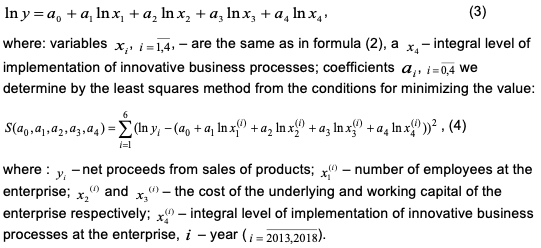
The method of least squares, the basis of which is laid down in the fundamental writings of Markov (1924), Chebotarev (1958), Yushchenko (1956), is a classical mathematical method for processing the results of measurements of various economic processes. It allows us to figure out the functional nature of the process, which in turn can be used to predict the magnitude of the studied characteristics.
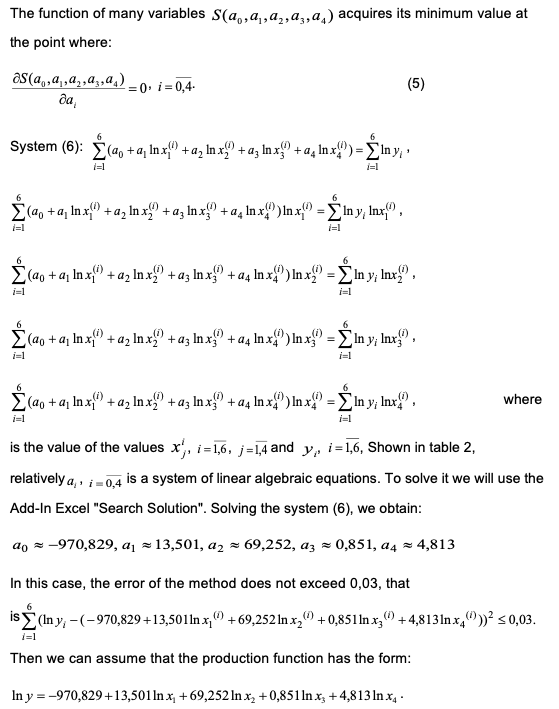
Table 2
Output data for PJSC "Eurocar"

Source: Formed by the authors according
to the statements of the enterprise
Thus, according to the results of modeling, the influence of factors on the development of PJSC "Eurocar" is determined. It is determined that with increasing expenses for labor resources, the value of working capital and increasing the level of implementation of innovative business processes in production, the volume of net income will grow. At the same time, the cost of fixed assets (as it has a negative power value) does not affect the trend of growth.
The sales and marketing chain of the association has its own distributor of "Atoll AutoTrading" LLC and a dealer network from enterprises of the "Autotrading-Center", "Autotrading-Kharkiv" and "Autotrading-Vinnitsa" subsidiaries. Therefore, it is logical to study the production function of a full chain cycle, taking into account the level of innovation of business processes.
In order to construct a production function for a complete cycle of the chain, we group the output data of enterprises in Table 3.
For the distributor of "Atoll AutoTrading" LLC, the production function will have the following appearance:

Table 3
Output data to determine the impact of factors on the e
nterprises of the production and sales chain of the association
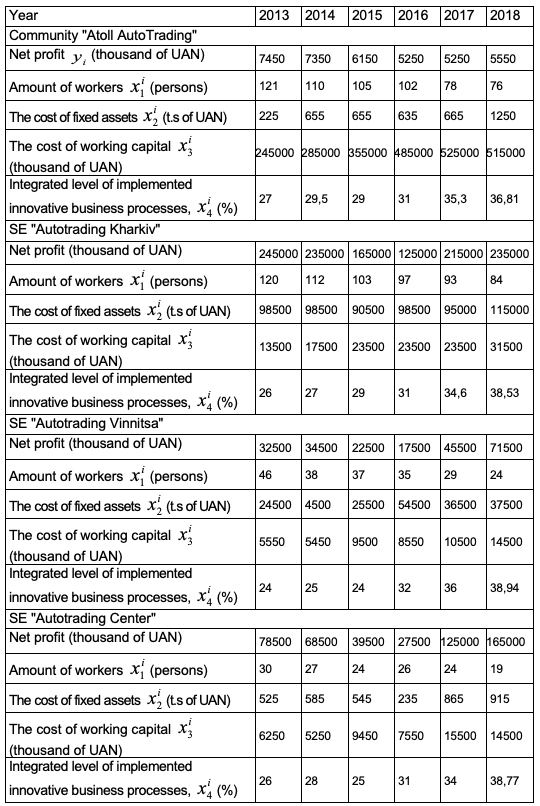
Source: formed by the authors according to the statements of enterprise
The production function for SE "Autotrading Kharkiv" will look like this:
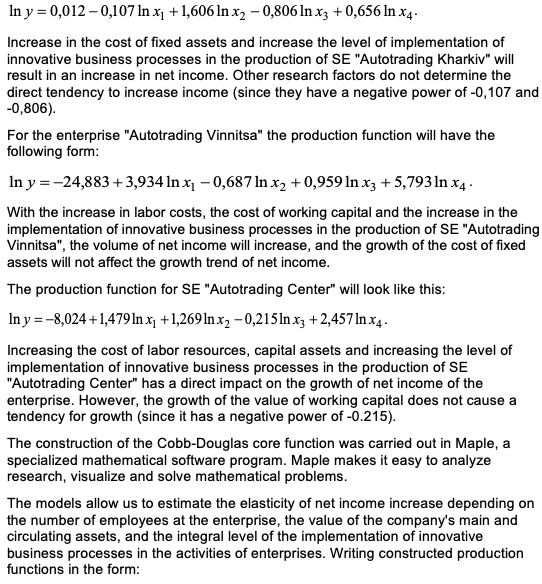
From the ratio of parameters a, b, and c, one can conclude that the factors influence on net income and the type of economic growth of enterprises (Table 4).
Table 4
Types of economic growth of enterprises and the influence of factors
on the results of activities in the production and distribution chain
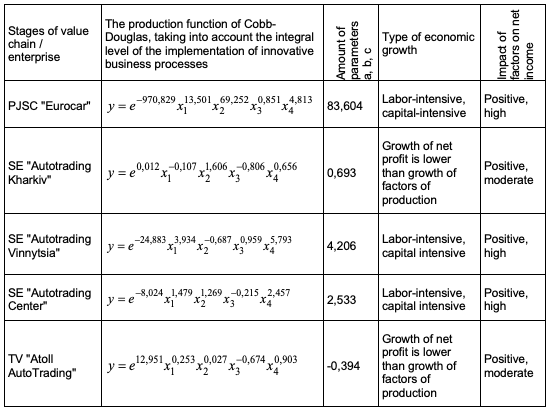
Source: calculated by authors.

The production and distribution chain of the association, there was mentioned such a tendency: PJSC "Eurocar" is characterized by capital-intensive, labor-consuming type of growth, the coefficient of the sum of parameters 83,604, in which the influence of innovative business processes is positive and high. For "Autotrading Kharkiv", the characteristic positive and moderate influence of innovative business processes, the type of growth is characterized by the condition: the growth of net profit is lower than the growth of factors of production at a coefficient of 0,63. A similar situation is characteristic for SE "Autotrading Center", the coefficient of the sum of parameters -0,394, in which the influence of innovative business processes is positive and moderate. At the "Autotrading Vinnitsa" SE there is a higher increase in net profit than the growth of factors of production. With a factor of 4,206, the impact of innovative business processes is positive and high. On "Atoll AutoTrading" Ltd, net profit growth is lower than the growth of production factors, which is considered to be a negative aspect of the activity. However, the number of staff (respectively, the cost of labor costs) and the level of implementation of innovative business processes have a positive effect on net income of enterprises. Consequently, it was based on the linear logarithmic models of the five companies that are part of the production and distribution chain.
The associations have made it possible to find out / demonstrate the efficiency of using the resources of the investigated enterprises, and also allow them to be used for forecast calculations.
According to the forecast estimations of factors of production during 2019-2023, the forecast net income for the enterprises of the production and sales chain of the association is calculated within the confidence interval of the forecast (Table 5).
According to the results of the forecast, it was established that, with the interaction of the five companies investigated in the production and supply chain of value added, in the conditions of continuous introduction of innovative business processes at enterprises, net income of enterprises can constantly increase (during the projected 5 years).
Table 5
Forecast of net income of enterprises that are part of
the production and distribution chain of the association
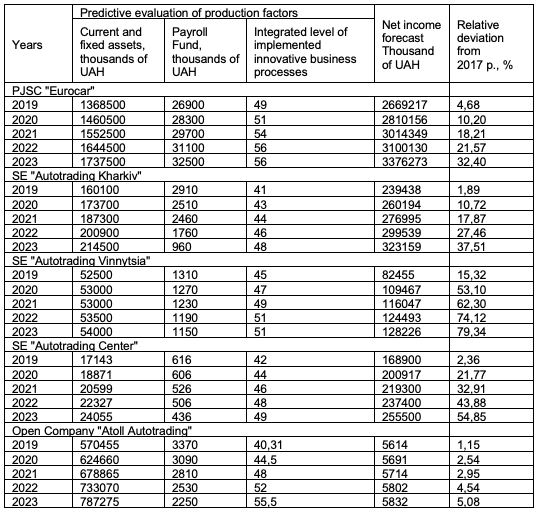
Source: calculated by authors.
The maximization of net income is projected for 2022-2023 for each enterprise included in the production and distribution chain of the association. Therefore, it is advisable to focus on ensuring stability and fulfilling the conditions of continuous operation at each stage of the production and distribution chain of value added.
The tough business conditions of the present force the enterprises to form strategic alliances, clusters. Each enterprise in the system of production-marketing communications, specializing in certain activities in value added chains, should use the possibilities of integration, combination of industrial, scientific and managerial potential for economically favorable conditions of production, sales of products, customer service, and management of innovation processes. Integrated communications are characterized by vertical sequential actions in the process of supplying resources, production, sales, after-sales and service. Integrated sales and marketing chain of the association covers processes from the very beginning (input conditions of business processes realization) up to the market of products and corresponding servicing. The result of the effective integration of production and marketing business processes at the outlet is the economically advantageous conditions for the production, sale, service of products, effective process management, implementation of opportunities for efficient use of capacities, optimization of business processes at each stage of the production and distribution chain added cost.
The authors construct linear-logarithmic models of five enterprises that are part of the production and distribution chain of the association, analyze the influence of factors on the results of enterprises. The factorial models of the enterprises of the production-supply chain of the added value are constructed with the help of the use of the Maple software product. The selection of factors is determined for the investigated enterprises taking into account the specifics of their activities. Among the factors influencing the performance of enterprises, the most important ones are allocated: labor costs, fixed assets cost, working capital costs and the level of implementation of innovations.
The adequacy and accuracy of the constructed models of the production and sales chain of value added of the association have made it possible to determine the influence of factors (labor costs, fixed assets cost, cost of circulating assets and the integral level of innovative business processes) on the results of the activities of the enterprises under study in the value added chain, and also became the basis for forecast calculations.
Projected indicators of net income of enterprises are forecast. The results of the forecast show that the continuous introduction of innovations in enterprises leads to an improvement in the results of their activities. It is also advisable to use the results of forecasting when making managerial decisions, focusing on the optimal values of resource support for the processes of "production-sales-service" of enterprises and the implementation of conditions for uninterrupted economic activity at each specific stage of the value chain. It is also strategically important to ensure the stability of the functioning of the cluster consolidation
The proposed scientific and methodical approach to determining the influence of factors on the results of the enterprises solves the problem of comparative analysis, optimization of business processes; can serve as a superstructure for other methods designed to solve imperfectly formalized tasks that use experience, intuition versus complex mathematical calculations. It is important that this approach can be used to create a model of the influence of factors on the results of enterprises and other industries.
-------------------------------------------------
The work was carried out within the framework of the state budget scientific research topic number 7B-2016 "Models and technologies of cluster formation in the strategies of institutional development of socio-economic systems" (2016-2018 years, state registration number 0116U001551). This work was supported by the Ministry of Education and Science of Ukraine.
The authors declared no potential conflicts of interest with respect to the research, authorship, and/or publication of this article.
Bhanumurthy, K. V. (2002) Arguing a case for the Cobb-Douglas production function. Review of Commerce Studies, Delhi, India, 3, 75-91. https://www.researchgate.net/profile/K_V_Bhanu_Murthy/publication/23742938_Arguing_a_Case_for_Cobb-Douglas_Production_Function/links/0fcfd5057eecba101b000000/Arguing-a-Case-for-Cobb-Douglas-Production-Function.pdf
Blahodyr, L. M. (2016). Metodychni zasady otsiniuvannia efektyvnosti funktsionuvannia pidpryiemstva iz vykorystanniam vyrobnychykh funktsii. Matematychni metody, modeli ta informatsiini tekhnolohii v ekonomitsi. Ekonomika i suspilstvo, 4, 378-384. http://www.economyandsociety.in.ua/journal/4_ukr /62.pdf.
Chebotaryov, A. S. (1958) Sposob naimenshih kvadratov s osnovami teorii veroyatnostey. Moskva: Geodezizdat. 606 s.
Dykha, M. V., Tanasiienko, N. P. & Kolisnyk, G. M. (2017). Ensuring of labor productivity growth in the context of investment and innovation activity intensification. Problems and Perspectives in Management, 15(4), 197-208. http://dx.doi.org/10.21511/ppm.15(4-1).2017.04
Fasse, Anja C., Grote, Ulrike & Winter, Etti (2011). Recent developments in apply-ing environmental value chain analysis. Environmental Economics, 2(3). Р. 62. https://www.researchgate.net/publication/216173671_Recent_developments_in_applying_environmental_value_chain_analysis
Hrabovetskyi, V. Ye. (2006) Vyrobnychi funktsii: teoriia, pobudova, vykorystannia v upravlinni vyrobnytstvom. UNIVERSUM–Vinnytsia, 138 s.
Hurochkina, V. V. & Menchynska, O. M. (2018) Intehratsiini vyrobnychi lantsiuhy ta mistse ukrainskoho mashynobuduvannia v mizhnarodnykh reitynhakh. Zbirnyk naukovykh prats Universytetu derzhavnoi fiskalnoi sluzhby Ukrainy. Ekonomichni nauky, 2, 41-56. http://ojs.nusta.edu.ua/index.php/ojs2/article/view/38/38
Hurochkina, V. (2015) Innovatsiinyi potentsial pidpryiemstva: sutnist ta systema zakhystu. Ekonomika: realii chasu. Naukovyi zhurnal, Odesa. 5(21), 51-57. https://economics.opu.ua/files/archive/2015/No5/51.pdf
Hudson, R. (2004) Conceptualizing economies and their geographies: spaces, flows and circuits. Progress in Human Geography, 28, 4, 447-471, Р. 462. https://pdfs.semanticscholar.org/cfd6/42fa9662194a6536a314bbd14b528cefe5f8.pdf
Kozhukhіvska, R., Parubok, N., Petrenko, N., Podzihun, S. & Udovenko, I. (2017). Methods of assessment of efficiency of creating regional innovative clusters for dynamic development of economics. Investment Management and Financial Innovations, 14(3), 302-312. http://dx.doi.org/10.21511/imfi.14(3-2).2017.01
Mansson J. (2003). How Can We Use The Result From A DEA Analysis? Identification of Firm–Relevant Reference Units. Journal of Applied Economics, Vol. 6, No. 1, 157-175. https://ageconsearch.umn.edu/bitstream/44072/2/mansson.pdf
Markov, A. A. (1924) Ischislenie veroyatnostey. Moskva: Gosizdat, 279 s. https://www.twirpx.com/file/1591868/
Melikhov, A. A. (2014) Modeliuvannia innovatsiinoi skladovoi konkurentnoho rozvytku promyslovykh pidpryiemstv. Ekonomichnyi visnyk Donbasu, 3(37), 144 http://nbuv.gov.ua/UJRN/ecvd_2014_3_24
Porter, M. (1985). Competitive Advantage: Creating and Sustaining Superior Performance. New York: Free Press, 557 p. https://www.albany.edu/~gs149266/Porter%20(1985)%20-%20chapter%201.pdf
Voynarenko, M. (2000) Kontseptsiia klasteriv – shliakh do vidrodzhennia vyrobnytstva na rehionalnomu rivni. Ekonomist, 1, 29-33.
Voynarenko M. & Bohatchyk L. (2014). Vykorystannia klasternoho instrumentariiu pry rozrobtsi subrehionalnykh stratehii pidvyshchennia konkurentospromozhnosti ekonomiky rehioniv. Actual problems of economics, № 8 (158), 171-182. http://nbuv.gov.ua/UJRN/ape_2014_8_22.
Voynarenko, M., Dykha, M. V., Mykoliuk, O., Yemchuk, L. & Danilkova, A. (2018). Assessment of an enterprise’s energy security based on multi-criteria tasks modeling. Problems and Perspectives in Management, 16(4), 102-116. http://dx.doi.org/10.21511/ppm.16(4).2018.10
Voynarenko, M. & Menchynska, O. (2018) Formation prospects of the automotive cluster in Ukraine under the conditions of economic space globalization. The Actual Problems of the World Today. London: Science Publishing.http://www.sciemcee.org/library/books/london/theactualproblemsoftheworldtoday/index.html
Zakharkin, O. O., Basantsov, I. V., Myroshnychenko, I. O., & Shcherbachenko, V. O. (2019). Analysis of the innovative development directions for industrial enterprises. Espacios, 40(27). https://www.revistaespacios.com/a19v40n27/a19v40n27p16.pdf
1. First Vice-rector, Khmelnytsky National University, Ukraine, Doctor of Economics Sciences, Professor; voynarenko@ukr.net; http://orcid.org/0000-0002-1301-1492
2. epartment of Economics of Enterprise and Entrepreneurship, Khmelnytsky National University, Ukraine, Doctor of Economics Sciences, Professor; dyha-mv@ukr.net; http://orcid.org/0000-0003-4405-9429
3. Department of Economics of Enterprise, University of the State Fiscal Service of Ukraine, Ukraine, PhD in Economics, Associate Professor; viktoriav2005@ukr.net; http://orcid.org/0000-0001-8869-0189
4. Department of Economics and International Relations, Vinnytsia Institute of Trade and Economics of KNUTE, Ukraine, PhD in Economics, Senior Lecturer; derkacholena@ukr.net; http://orcid.org/0000-0002-1549-4870
[Index]
revistaespacios.com

This work is under a Creative Commons Attribution-
NonCommercial 4.0 International License